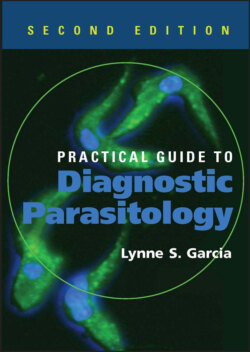Читать книгу Practical Guide to Diagnostic Parasitology - Lynne Shore Garcia - Страница 76
На сайте Литреса книга снята с продажи.
Different Approaches
ОглавлениеDuring the past few years, recommendations regarding the collection, processing, and testing of stool specimens for diagnostic parasitology have been under review. New suggestions and options have arisen as a result of cost containment measures, limited reimbursement, and the elimination of mercury-based compounds for stool preservatives. The number of nonmercury preservative choices, collection systems, concentration devices, and immunoassays has increased dramatically.
It is important to realize that different laboratories will select different approaches. These differences should not be categorized as “right or wrong” or “acceptable or unacceptable”; they are merely different! To assume that there is only one correct approach for the examination of stool specimens is neither appropriate nor realistic. There are many factors to consider before selecting the approach for your own laboratory. In no particular order, some of the considerations include client base, physician ordering patterns, number of specimens received per month, cost, presence or absence of appropriate equipment, current and possible methodologies (including the new immunoassays such as enzyme immunoassay [EIA], fluorescent-antibody assay [FA], and rapid tests [membrane flow cartridge devices]), availability of expert microscopists, collection options, selection of preservativestain combinations, reimbursement issues, client education, area of the world where the laboratory is located, and emphasis on the most common infections (helminth or protozoa or both) seen in that geographic location.
When laboratory test menus are being developed, the pros and cons of the approaches selected need to be thoroughly understood, and diagnostic tests, potential results, and reporting formats should be carefully explained to all clients. As an example, if the results of a stool examination are based on a concentration sediment examination only, this information must be conveyed to the physician. Many of the intestinal protozoa are missed when this diagnostic test approach is used, and it is important for the physician to recognize the limitations of such testing. Most physicians receive very little, if any, exposure to medical parasitology in medical school, and many newer physicians trained as generalists or family practitioners also have limited parasitology training or experience (Table 3.1).
It is usually realistic to assume that patients are symptomatic if they are submitting stool specimens for diagnostic parasitology testing. In an excellent article by Hiatt et al., the premise tested was that a single stool specimen from a symptomatic patient would be sufficient to diagnose infections with intestinal protozoa. However, with additional stool examinations, the yield of intestinal protozoa from symptomatic patients increased dramatically (Entamoeba histolytica, 22.7% increase; Giardia lamblia, 11.3% increase; and Dientamoeba fragilis, 31.1% increase). This publication again demonstrates the problems associated with performing only a single stool examination (using the ova and parasite examination [O&P exam]). If the patient becomes asymptomatic after examination of the first stool specimen, it may be acceptable to discontinue the series of stool examinations (this should be a clinician decision).
Available options will be compared to the “gold standard,” which includes a series of three stool examinations (direct, concentrate, and permanent stained smear for a fresh specimen; concentrate and permanent stained smear for a preserved specimen). The single-specimen pros and cons are discussed in the previous paragraph (symptomatic versus asymptomatic patients). A suggestion has been made to pool three specimens and to perform a single concentration and a single permanent stained smear on the pooled specimen sample. Depending on the number of positives and negatives, this may be a viable option, but some organisms may be missed. Another testing option for three pooled specimens is to perform a single concentration and three separate permanent stained smears. This approach would probably increase the yield of intestinal protozoa over the previous option. Another suggestion involves placing a sample of each of three stools into a single vial of preservative. This collection approach would require only a single vial, but it is very likely that the vial would be overfilled and that mixing and the ratio of fixative to stool would be inaccurate.
Fecal immunoassays could also be used for G. lamblia, the E. histolytica/E. dispar group, E. histolytica, or Cryptosporidium spp. However, information about patient history is rarely received with the clinical specimen; fecal testing based on the risk group or recent activity of the patient is impossible without sufficient information. Testing by immunoassay procedures should be performed on request; however, client education is critical for successful implementation of this approach. Collection and testing options and their pros and cons can be seen in Tables 3.1 and 3.2.
The Clinical Laboratory Standards Institute/National Committee for Clinical Laboratory Standards document Procedures for the Recovery and Identification of Parasites from the Intestinal Tract (approved guideline M28-2A) was updated in 2005. Various stool collection, processing, and testing options are also included in that publication.
In summary, laboratories performing diagnostic parasitology testing must decide on the test methods that are relevant for their own operations based on a number of variables mentioned above. It is unrealistic to assume or state that one approach is applicable for every laboratory; however, it is important to thoroughly understand the options within your test menu and to convey this information to your clients once your approach has been selected for implementation. Prior discussion with clients, written educational memos, meetings, and examples of revised report formats are highly recommended prior to implementation. Based on available testing options, it is recommended that laboratories include both the O&P exam and various fecal immunoassays in their test menus.
